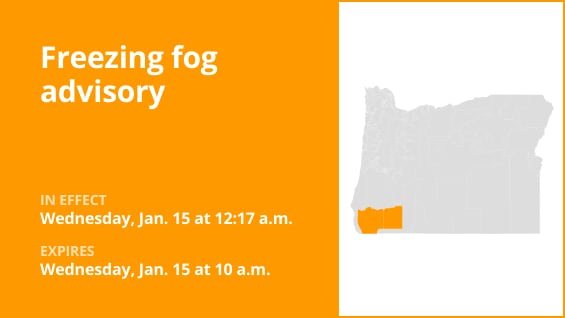The National Weather Service issued a freezing fog advisory for Eastern Curry County, Josephine County, and Jackson County on Wednesday at 12:17 a.m., with a 10-a.m. expiration date.
Expect “Visibility one quarter mile or less in freezing fog,” the weather agency said. “Throughout the advisory period, particularly throughout the nighttime and morning hours, strong valley inversions, calm winds, and extremely shallow mixing layers of less than 1000 feet are anticipated. On Thursday, there might be a small window of better mixing and particulate dispersion due to a weak front.
“Driving conditions could be dangerous due to low visibility. Spots of ice may form on roads due to freezing fog. People with respiratory conditions may experience difficulty due to poor air quality, the weather agency said. “If you’re driving, use your headlights, slow down, and give yourself plenty of space. When it comes to dealing with high levels of air pollution during periods of stagnant air, people with respiratory illnesses should heed the advise of their doctors. State air quality organizations strongly advise against outdoor burning and to minimize the number of wood-burning equipment in homes. Long stretches of stagnant air can trap pollutants near the ground where people live and breathe, according to state air quality regulators. For information on any current limitations in your area, contact your local burn agency.
What does a freezing fog advisory mean?
An advisory for freezing fog is a critical warning when fog is expected to form at or below freezing temperatures. Under such circumstances, the fog’s minuscule liquid droplets have the ability to quickly freeze when they come into touch with objects, such as cars and roads. Visibilities frequently fall to a mile or less as a result of this phenomena, which dramatically increases the risks involved in driving, sailing, flying, and other forms of transportation.
A freezing fog: what is it?
A close relative of ice, freezing fog forms similarly to ordinary fog. When the skies are clear, heat travels into space, causing the Earth’s surface to cool. This is how fog and freezing fog begin. The air’s ability to hold onto moisture diminishes as this cooling process goes on, which causes water vapor to condense into tiny liquid droplets—the fundamental building blocks of fog. “Supercooling” is the term for the phenomena whereby the water droplets in this fog stay liquid when it occurs at temperatures below freezing. Essentially, supercooling is the process by which a liquid stays liquid because there is no freezing surface present, even when it is below its freezing point.
These supercooled droplets experience a stunning metamorphosis upon coming into contact with surfaces, crystallizing into fragile ice formations called rime. Trees, plants, and other environmental features, as well as vertical surfaces exposed to prevailing winds, frequently exhibit this change. In actuality, rime can develop on a number of surfaces, such as sidewalks, highways, railings, stairs, and even automobiles.
Black ice: what is it?
Clear ice, sometimes referred to as black ice, is a thin, almost undetectable layer of glaze ice that accumulates on a variety of surfaces, particularly roads. Despite its name, the ice is not black; rather, it has extraordinary transparency, which allows the black road pavement underneath to be seen.
Freezing fog is often blamed for the production of black ice, which can quickly cover roads with this dangerous threat. Due to its near-invisibility, black ice is particularly dangerous since it is difficult for drivers to notice.
How can I keep myself safe?
Avoiding travel if at all feasible may be the safest course of action when freezing fog covers your surroundings. If going out becomes inevitable, go with extreme caution and follow these crucial safety precautions:
High alertness:
Keep an eye out because the infamous black ice, which is still difficult to detect, can form from freezing fog.
Slow down:
Reduce your speed when driving, particularly if there is a suspicion of slippery conditions.
Priority for visibility:
Use low-beam headlights, which also turn on your taillights, to make sure that people can see your car. Make use of your fog lights if you have them.
Steer clear of high beams:
Avoid using high-beam lights as they produce glare, which makes it harder to see what’s in front of you on the road.
Remain at a safe distance:
Keep a considerable following distance in order to accommodate sudden stops or changes in traffic patterns.
Remain in your lane:
To stay in the proper lane, follow the lane lines on the road.
Remember that even a tiny film of ice can build on aircraft surfaces, posing serious threats to flight safety for those who are flying to the skies. Before you take off, make sure the aircraft has been adequately treated or has efficient de-icing systems installed.
Knowledge and alertness are your unwavering partners in the world of freezing fog, enabling you to handle these weather-related challenges with your safety as your top priority.
United Robots offers a service called Advance Local Weather Alerts that gathers the most recent information from the National Weather Service using machine learning.







